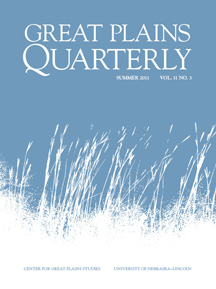
In the summer issue of Great Plains Quarterly, an academic journal published by the Center for Great Plains Studies, researchers wrote about late 19th-century immigration to the Great Plains, the political economy of the Yankton Sioux during the 1930s, and social disruption created by the current time zone boundaries.
In "Immigration to the Great Plains, 1865-1914: War, Politics, Technology and Economic Development," Bruce Garver explores the immigration to the Great Plains in the context of the international political and economic changes. He writes about the transformation of the Great Plains from a sparsely inhabited frontier to a region of thriving cities and commercial agriculture. "This transformation took place in the remarkably short time of 49 years, during which Europe and North America enjoyed unprecedented peace and prosperity," wrote Garver, professor of history at the University of Nebraska at Omaha.
Teresa M. Houser studied the New Deal policies and their effect on the Yankton Sioux Reservation in "New Deal Experimentation and the Political Economy of the Yankton Sioux, 1930-1934." She argues that "New Deal policies complicated for decades the political and economic development of the tribe," and concludes that "well-intended policies frequently fell short of achieving meaningful short-term gains, as this case study of the Yankton Sioux Reservation demonstrates." Houser teaches in the history and political science departments at UNO.
In "Joining the Great Plains in Space, Place and Time: Questioning a Time Zone Boundary," Rob Kuper, assistant professor of landscape architecture at Temple University, discusses the invisible time zone boundary between mountain standard time and central standard time that bisects the Great Plains states. "Communities on either side of the MST-CST zone boundary are united by time but may not be related by environmental characteristics," said Kuper, who walked from the west to the east across Nebraska, his birthplace, to learn more about its landscape.
Current issues of the journal may be purchased in the Great Plains Art Museum gift shop at 1155 Q St., or by calling the center at (402) 472-3082. Order forms are available online at http://www.unl.edu/plains.
- Linda Ratcliffe, Center for Great Plains Studies,
More details at: http://go.unl.edu/0pf